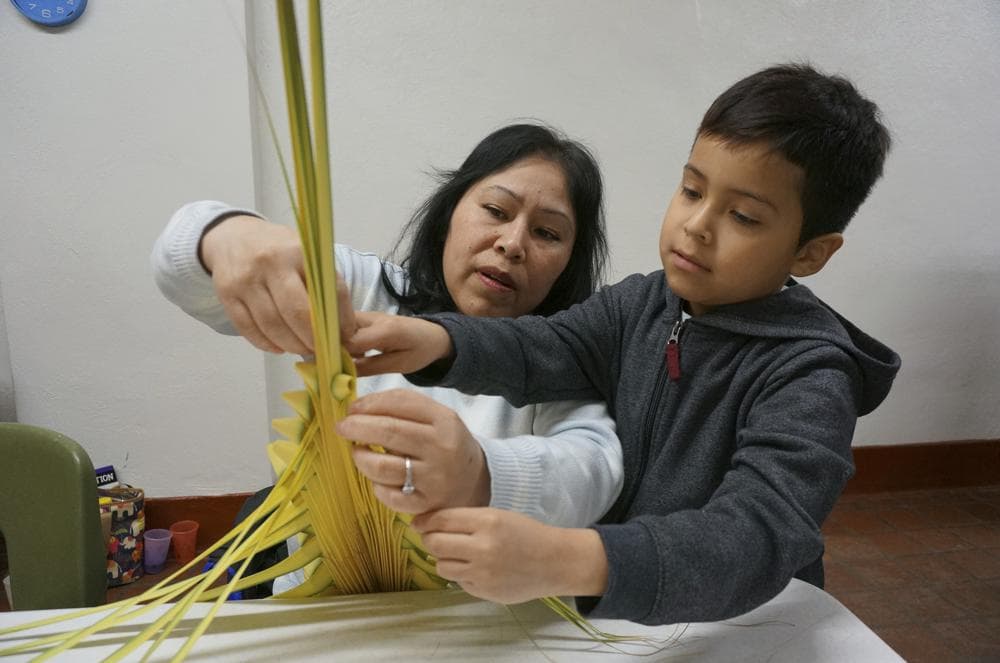MINNEAPOLIS — As new volunteers kept streaming into the Church of the Incarnation, Reynaldo Hidalgo prepped fresh palm fronds for them to weave into elaborate designs that will be blessed at services on Palm Sunday, the start of Christianity’s holiest week.
“It’s to give welcome to the king, our Lord Jesus Christ,” said Hidalgo, who has led traditional Mexican palm weaving workshops here for half a dozen years, along with his wife. “We wanted to keep a memory of this tradition.”
Many Christians around the world will be getting blessed palm or other tree branches this weekend, in commemoration of Jesus’s triumphant entry into Jerusalem, when the Gospel narrates that crowds spread branches on the road before him.
At Hidalgo’s Catholic church, and others across the country where parishioners observe the Easter traditions of many Latin American and European countries, the fronds are woven and braided into intricate designs of up to several feet, often decorated with rosettes, ribbons and images of Jesus or the saints.
It’s a celebration not just of faith, but ancient cultural crafts, often related to spring and farming rituals, that they’re eager to pass on to younger generations.
Teens and younger children, some lugging their homework, gathered Wednesday in Incarnation’s basement, where the tropical perfume of fresh palms contrasted with the below-freezing evening outside.
Maria Consuelo Palapa came with her 7-year-old son, Omar, “first to help the church, and to teach the child my traditions” from the Mexican state of Puebla.
When she ran into trouble weaving the back of a two-foot-long palm shaped into a giant flower, she consulted Hidalgo’s wife, Isabel Tenorio, who supervised the efforts to produce more than 400 palms before this weekend’s Masses. They will be sold then, all proceeds going to the community outreach and maintenance costs of the historic church.
“I would like that the community kept this going, to help our church,” Tenorio said as the woven fronds piled up on the large table in front of her and so many volunteers kept coming that some tried their hand at the craft standing up.
One of the first to arrive was Adriana Mozo, a long-time parishioner but first-time weaver whose parents migrated from Mexico.
“I’m very crafty, but this is wild,” she said as she tackled the green fronds, brittle and resistant at the same time. She bought one a couple of years ago that’s still framed in her dining room. “It feels like a connection to God.”
The palms are kept in places of honor in many homes for a year, when they’re traditionally burned to make ashes for the Ash Wednesday celebrations that mark the beginning of Lent.
“It’s a form of ratifying a pact by Mexican believers with the Catholic religion,” said Elio Masferrer, an anthropologist at Mexico’s National School of Anthropology and History. “It’s a form of endorsing a social alliance,” especially for migrant communities.
At Saint Michael Church in New Haven, Connecticut, Jean Quartiano started weaving workshops precisely so that a tradition brought over by nuns from Italy nearly a century ago wouldn’t be lost. This week, she’s been at the church up to 12 hours a day, training volunteers to braid palm crucifixes they will sell at Mass, to help keep the lights on in the shrinking parish.
“We’re going to keep the tradition alive as long as we can,” Quartiano said.
Back in Minneapolis, a high school junior who came for the chance to learn a new craft lined up for Tenorio’s advice behind a mother and daughter duo who remembered seeing artisans selling the palm designs outside churches in their native Puebla.
“I was raised in this culture, where it’s a blessing to have a little blessed palm,” Kari Mendoza said as her mother nodded.
Victor Ramirez came with his wife and 16-year-old son to learn to weave palms, which his grandparents kept in their home in the Mexican state of Morelos as protection against storms and other evils.
Even with a finger in a splint, he was soon deftly and quickly creating palm rosettes to decorate the much larger creations.
“We all keep palms as a symbol of joy,” Ramirez said.













